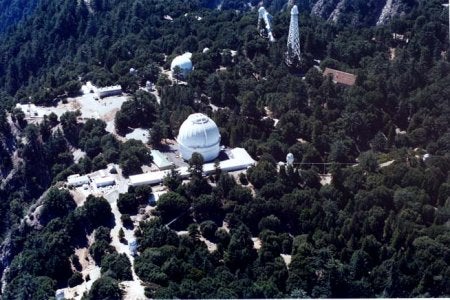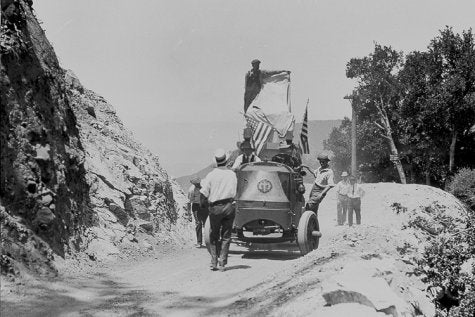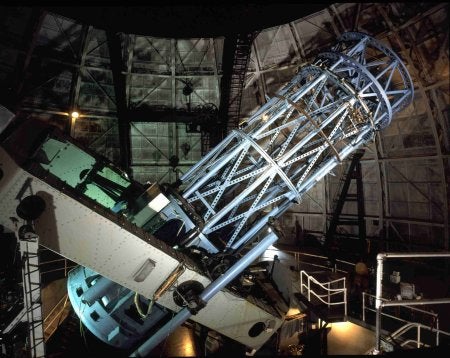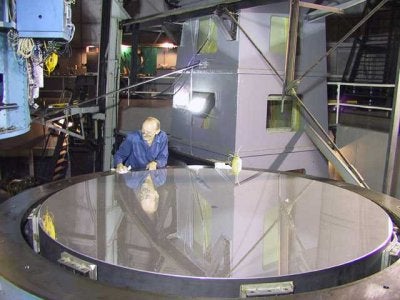1904
George Ellery Hale’s spent his first year on Mount Wilson.
The Snow Solar Telescope became the first instrument installed on the mountain — a loan from Yerkes Observatory in Wisconsin. Named for the father of benefactor Helen Snow, the telescope never returned to its original institution.
Hale ordered a 100-inch mirror for the observatory.
The 60-foot solar tower was completed. Built on a windmill tower ordered from a catalog, it was designed to avoid the ground-heating distortions experienced by the Snow Solar Telescope’s horizontally mounted optics.
The 60-inch telescope saw first light. Originally planned for the Yerkes Observatory, it was built to study stellar evolution. Worker strikes and the 1906 earthquake delayed construction several times, but when the telescope was finished, it was the world’s largest for nine years.
Observations made this year from the 60-foot solar tower led Hale to discover that sunspots have magnetic fields, marking the first detection of extraterrestrial magnetism.
Hale built the 150-foot solar tower.
Harlow Shapley began work at the observatory as a staff astronomer. He used the 60-inch telescope to measure the distance to globular star clusters, showing the Milky Way was larger than previously thought (although his calculation of the galaxy’s diameter — 300,000 light-years — is too large by about a factor of three). His observations also showed that the sun does not lie at the center of the Milky Way.
Originally covered only by canvas, the 60-foot solar tower telescope received a protective dome and a permanent observing building at ground level.
The Mount Wilson Toll Road was widened, mostly by Asian workers, to accommodate the trucks and large equipment necessary to construct the 100-inch telescope.
The 100-inch Hooker Telescope saw first light after several technical delays.
Albert Michelson measured star diameters with a 20-foot interferometer resting atop the 100-inch telescope.
Edwin Hubble used the 100-inch telescope to make observations proving the universe is much larger than the Milky Way galaxy. He noticed the telltale signs of a Cepheid variable star in the Andromeda “Nebula.” From the star’s magnitude, he concluded that the “nebula” was not a star cluster inside our own galaxy but a separate galaxy much farther away.
Hale and Seth Nicholson discovered a 22-year cycle of sunspot magnetism.
Hale began to plan a 200-inch telescope for Palomar Mountain between Los Angeles and San Diego.
Hubble used the 100-inch telescope to conclude that space is expanding. In what has since been named “Hubble’s Law,” he found that the farther away a galaxy is from Earth, the faster it recedes.
The development of long-lasting aluminum coatings put an end to the periodic resilvering of the 9,000-pound 100-inch mirror.
Hale died.
The 200-inch Hale Telescope saw first light on Palomar Mountain.
The 150-foot solar tower’s first magnetograph was installed by Horace Babcock.
Olin Wilson began the HK Project, which measures the H and K lines of ionized calcium in stellar spectra to monitor starspot cycles. The program continues today, and now more than 500,000 measurements have been made of more than 3,000 stars.
The 100-inch telescope was designated an International Historical Mechanical Engineering Landmark by the American Society of Mechanical Engineers.
The historic 100-inch telescope closed.
The first two telescopes of the University of California at Berkeley’s three-telescope array, the Infrared Spatial Interferometer, or ISI, began operations. The third scope arrived at the observatory in 1998. The 65-inch instruments combine forces to study red giant and Mira variable stars. They also precisely measure stellar positions.
A 24-inch telescope at the observatory, which was originally used to study the moon in preparation for NASA’s Apollo missions, was refurbished for the Telescopes In Education program. TIE allows students anywhere in the world to use the telescope over the Internet.
The Mount Wilson Institute re-opened the 100-inch telescope.
A second, 14-inch telescope was installed at the observatory for the TIE program. (In 2000 and 2002, two southern-hemisphere telescopes were added to the program, one in Chile and one in Australia, respectively.)
The CHARA Array, a group of six interconnected one-meter telescopes, became a fully used science instrument. The optical interferometer is named for its parent institution, Georgia State University’s Center for High Angular Resolution Astronomy.













